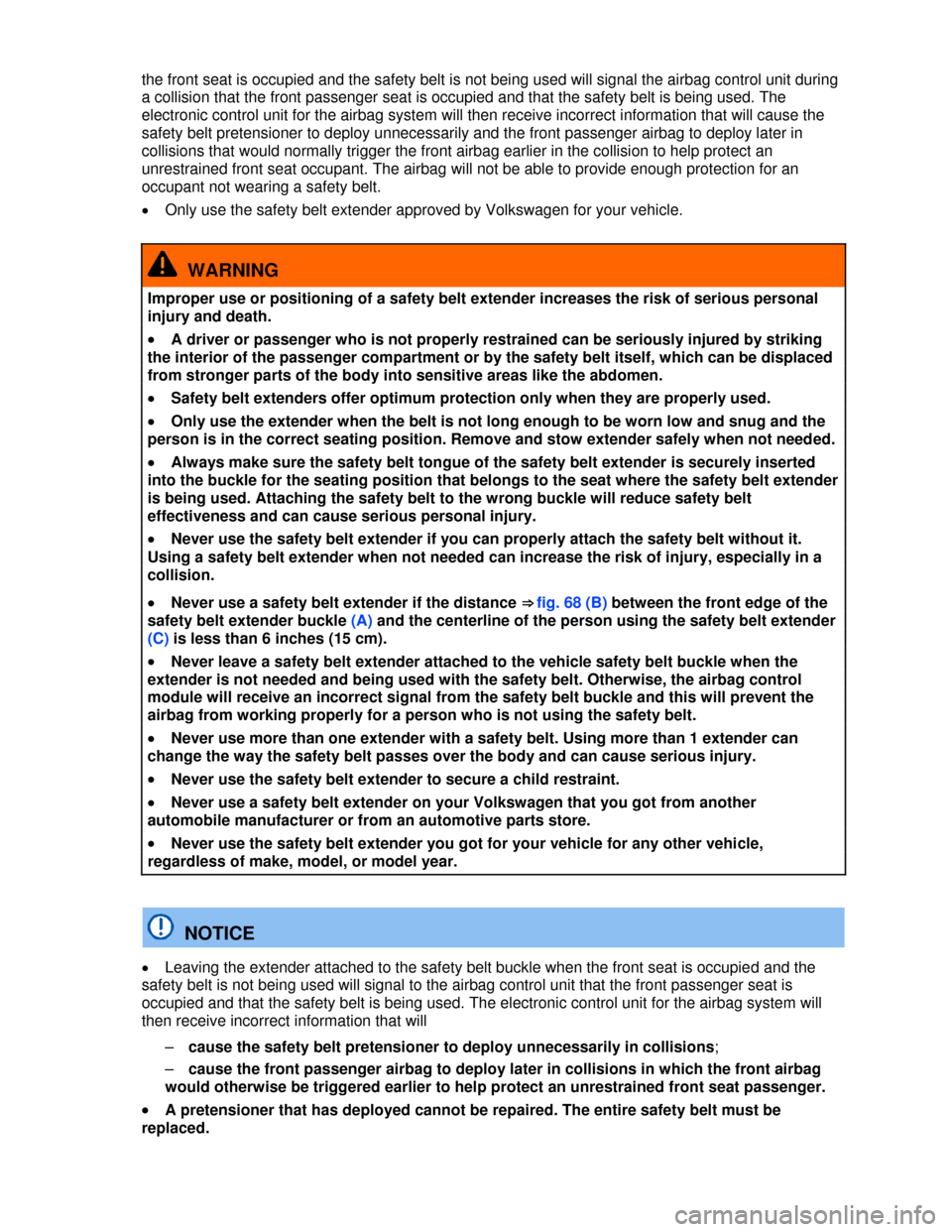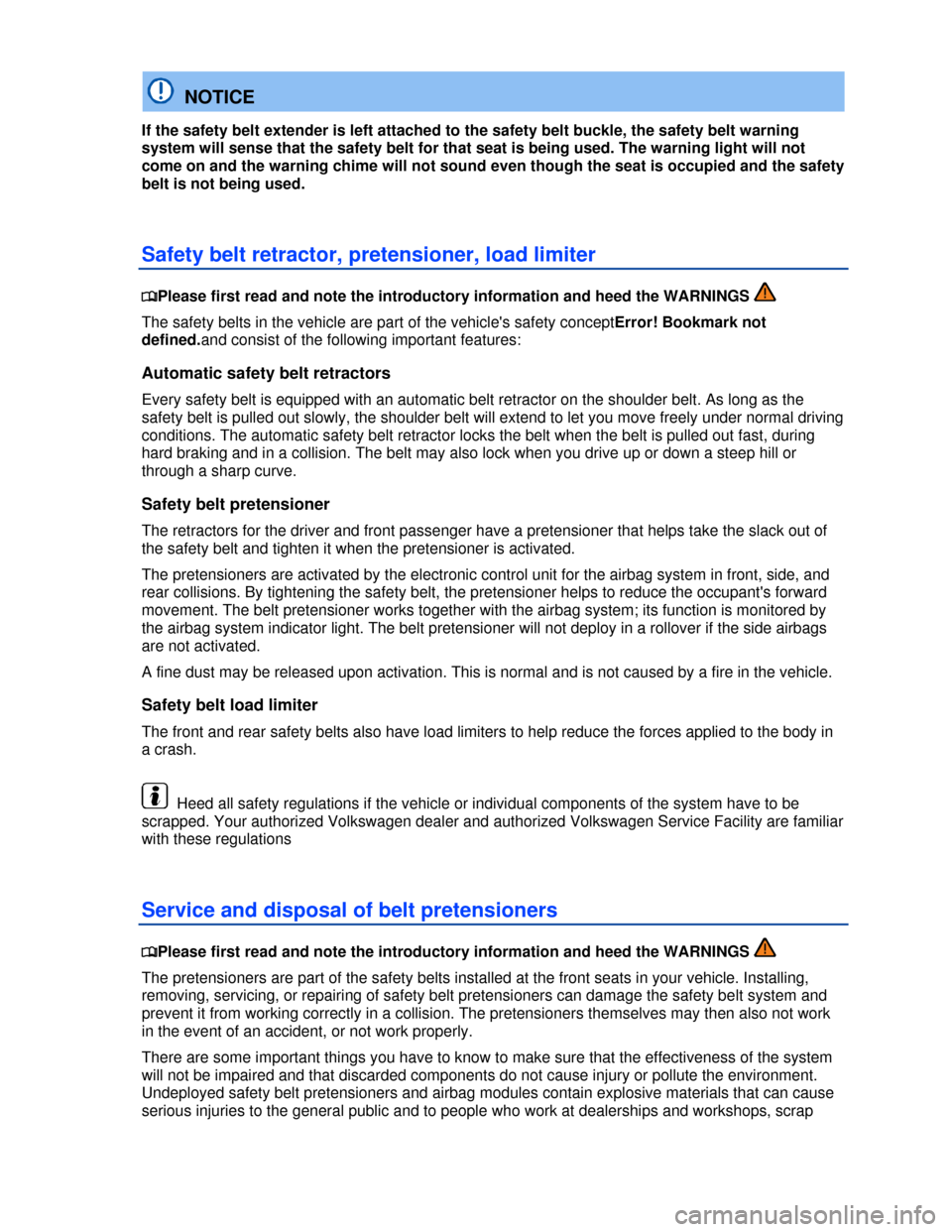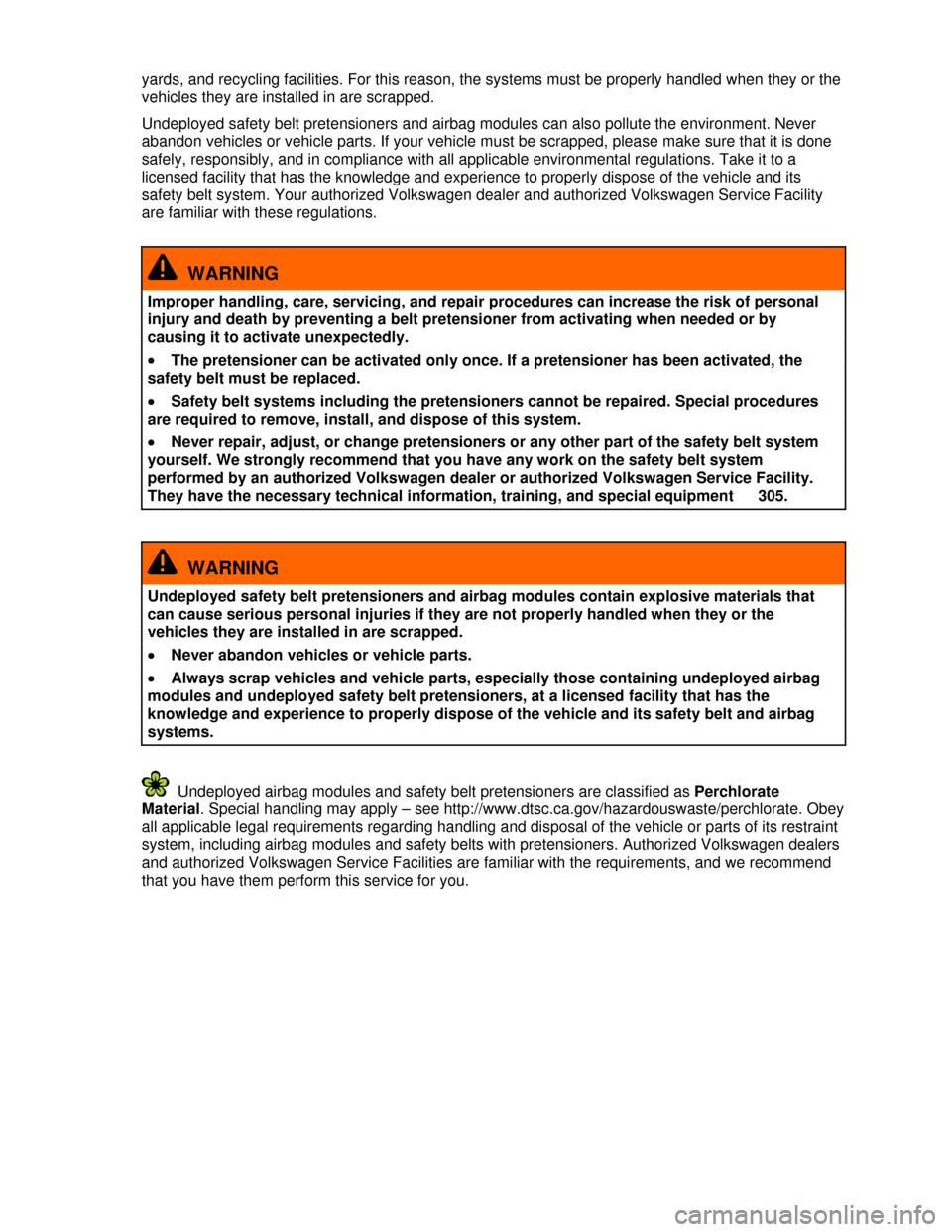2013 VOLKSWAGEN TIGUAN Tensioner
[x] Cancel search: TensionerPage 98 of 356

the front seat is occupied and the safety belt is not being used will signal the airbag control unit during
a collision that the front passenger seat is occupied and that the safety belt is being used. The
electronic control unit for the airbag system will then receive incorrect information that will cause the
safety belt pretensioner to deploy unnecessarily and the front passenger airbag to deploy later in
collisions that would normally trigger the front airbag earlier in the collision to help protect an
unrestrained front seat occupant. The airbag will not be able to provide enough protection for an
occupant not wearing a safety belt.
�x Only use the safety belt extender approved by Volkswagen for your vehicle.
WARNING
Improper use or positioning of a safety belt extender increases the risk of serious personal
injury and death.
�x A driver or passenger who is not properly restrained can be seriously injured by striking
the interior of the passenger compartment or by the safety belt itself, which can be displaced
from stronger parts of the body into sensitive areas like the abdomen.
�x Safety belt extenders offer optimum protection only when they are properly used.
�x Only use the extender when the belt is not long enough to be worn low and snug and the
person is in the correct seating position. Remove and stow extender safely when not needed.
�x Always make sure the safety belt tongue of the safety belt extender is securely inserted
into the buckle for the seating position that belongs to the seat where the safety belt extender
is being used. Attaching the safety belt to the wrong buckle will reduce safety belt
effectiveness and can cause serious personal injury.
�x Never use the safety belt extender if you can properly attach the safety belt without it.
Using a safety belt extender when not needed can increase the risk of injury, especially in a
collision.
�x Never use a safety belt extender if the distance ⇒ fig. 68 (B) between the front edge of the
safety belt extender buckle (A) and the centerline of the person using the safety belt extender
(C) is less than 6 inches (15 cm).
�x Never leave a safety belt extender attached to the vehicle safety belt buckle when the
extender is not needed and being used with the safety belt. Otherwise, the airbag control
module will receive an incorrect signal from the safety belt buckle and this will prevent the
airbag from working properly for a person who is not using the safety belt.
�x Never use more than one extender with a safety belt. Using more than 1 extender can
change the way the safety belt passes over the body and can cause serious injury.
�x Never use the safety belt extender to secure a child restraint.
�x Never use a safety belt extender on your Volkswagen that you got from another
automobile manufacturer or from an automotive parts store.
�x Never use the safety belt extender you got for your vehicle for any other vehicle,
regardless of make, model, or model year.
NOTICE
�x Leaving the extender attached to the safety belt buckle when the front seat is occupied and the
safety belt is not being used will signal to the airbag control unit that the front passenger seat is
occupied and that the safety belt is being used. The electronic control unit for the airbag system will
then receive incorrect information that will
– cause the safety belt pretensioner to deploy unnecessarily in collisions;
– cause the front passenger airbag to deploy later in collisions in which the front airbag
would otherwise be triggered earlier to help protect an unrestrained front seat passenger.
�x A pretensioner that has deployed cannot be repaired. The entire safety belt must be
replaced.
Page 99 of 356

NOTICE
If the safety belt extender is left attached to the safety belt buckle, the safety belt warning
system will sense that the safety belt for that seat is being used. The warning light will not
come on and the warning chime will not sound even though the seat is occupied and the safety
belt is not being used.
Safety belt retractor, pretensioner, load limiter
�
Page 100 of 356

yards, and recycling facilities. For this reason, the systems must be properly handled when they or the
vehicles they are installed in are scrapped.
Undeployed safety belt pretensioners and airbag modules can also pollute the environment. Never
abandon vehicles or vehicle parts. If your vehicle must be scrapped, please make sure that it is done
safely, responsibly, and in compliance with all applicable environmental regulations. Take it to a
licensed facility that has the knowledge and experience to properly dispose of the vehicle and its
safety belt system. Your authorized Volkswagen dealer and authorized Volkswagen Service Facility
are familiar with these regulations.
WARNING
Improper handling, care, servicing, and repair procedures can increase the risk of personal
injury and death by preventing a belt pretensioner from activating when needed or by
causing it to activate unexpectedly.
�x The pretensioner can be activated only once. If a pretensioner has been activated, the
safety belt must be replaced.
�x Safety belt systems including the pretensioners cannot be repaired. Special procedures
are required to remove, install, and dispose of this system.
�x Never repair, adjust, or change pretensioners or any other part of the safety belt system
yourself. We strongly recommend that you have any work on the safety belt system
performed by an authorized Volkswagen dealer or authorized Volkswagen Service Facility.
They have the necessary technical information, training, and special equipment 305.
WARNING
Undeployed safety belt pretensioners and airbag modules contain explosive materials that
can cause serious personal injuries if they are not properly handled when they or the
vehicles they are installed in are scrapped.
�x Never abandon vehicles or vehicle parts.
�x Always scrap vehicles and vehicle parts, especially those containing undeployed airbag
modules and undeployed safety belt pretensioners, at a licensed facility that has the
knowledge and experience to properly dispose of the vehicle and its safety belt and airbag
systems.
Undeployed airbag modules and safety belt pretensioners are classified as Perchlorate
Material. Special handling may apply – see http://www.dtsc.ca.gov/hazardouswaste/perchlorate. Obey
all applicable legal requirements regarding handling and disposal of the vehicle or parts of its restraint
system, including airbag modules and safety belts with pretensioners. Authorized Volkswagen dealers
and authorized Volkswagen Service Facilities are familiar with the requirements, and we recommend
that you have them perform this service for you.
Page 178 of 356

Please perform these steps only in the order listed.
Vehicles without Keyless AccessVehicles with Keyless Access
4. Apply the electronic parking brake to help prevent the vehicle from moving .
5. Turn the remote control vehicle key
to position ⇒ fig. (0) in the ignition switch.
Briefly press the starter button ⇒ fig. . If the
engine will not switch off, carry out the
emergency shutoff procedure
6. With a manual transmission, shift into 1st gear (vehicle on flat surface or pointing uphill) or
reverse (vehicle pointing downhill).
7.
Removing the vehicle key from the ignition
switches off electrical equipment and
activates the steering column lock.
Opening the doors switches off electrical
equipment and activates the steering
column lock.
WARNING
Never stop the engine before the vehicle has come to a complete stop. You can lose control
of the vehicle, crash, and be seriously injured.
�x The airbags and safety belt pretensioners will not work when the ignition is switched off.
�x The brake booster does not work when the engine is not running. More brake pedal
pressure will be needed to stop the vehicle.
�x The power steering system does not work when the engine is not running, and you will
need more force to steer the vehicle.
�x When the key is removed from the ignition switch, the steering will lock and you will not
be able to steer the vehicle.
NOTICE
If the vehicle has been driven hard for a long time, the engine could overheat when it is
stopped. To reduce the risk of engine damage, let the engine idle in Neutral for about 2 minutes
before you switch off the ignition.
If the ignition is switched on or the engine is running and the driver door is opened, a chime
sounds. The chime is also a reminder to switch off the engine and turn off the ignition before leaving
and locking the vehicle from the outside.
On vehicles with automatic transmissions, the vehicle key can only be removed from the ignition
when the transmission is in Park (P).
After the engine has been switched off, the radiator fan in the engine compartment may keep
running for several minutes, or may start running after the vehicle has been parked for a while, even if
the ignition is switched off and the vehicle key has been removed. The radiator fan shuts off
automatically when the engine has cooled down enough.
Applicable only in Canada
Stopping the engine
�
Page 179 of 356

Please perform these steps only in the order listed.
Vehicles without Keyless Access
1. Bring the vehicle to a complete stop ⇒ .
2. Depress and hold down the brake pedal until step 4 is completed.
3. Automatic transmission: Shift the transmission into Park (P).
4. Apply the electronic parking brake to help prevent the vehicle from moving
5. Turn the remote control vehicle key to position ⇒ fig. (0) in the ignition switch.
6. With a manual transmission, shift into 1st gear (vehicle on flat surface or pointing uphill) or
reverse (vehicle pointing downhill).
7. Removing the vehicle key from the ignition switches off electrical equipment and activates
the steering column lock.
WARNING
Never stop the engine before the vehicle has come to a complete stop. You can lose control
of the vehicle, crash, and be seriously injured.
�x The airbags and safety belt pretensioners will not work when the ignition is switched off.
�x The brake booster does not work when the engine is not running. More brake pedal
pressure will be needed to stop the vehicle.
�x The power steering system does not work when the engine is not running, and you will
need more force to steer the vehicle.
�x When the key is removed from the ignition switch, the steering will lock and you will not
be able to steer the vehicle.
NOTICE
If the vehicle has been driven hard for a long time, the engine could overheat when it is
stopped. To reduce the risk of engine damage, let the engine idle in Neutral for about 2 minutes
before you switch off the ignition.
If the ignition is switched on or the engine is running and the driver door is opened, a chime
sounds. The chime is also a reminder to switch off the engine and turn off the ignition before leaving
and locking the vehicle from the outside.
On vehicles with automatic transmissions, the vehicle key can only be removed from the ignition
when the transmission is in Park (P).
After the engine has been switched off, the radiator fan in the engine compartment may keep
running for several minutes, or may start running after the vehicle has been parked for a while, even if
the ignition is switched off and the vehicle key has been removed. The radiator fan shuts off
automatically when the engine has cooled down enough.